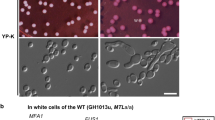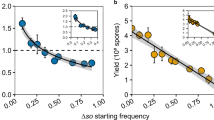Abstract
THE sexual cycle of the smut fungus, Ustilago violacea, is initiated by conjugation between uninqcleate, yeast-like haploid sporidia of opposite mating type. The mating type is determined by a pair of alleles (a1 and a2). Mating is achieved by the cooperative assembly of a tube between the paired sporidia. After copulation the haploid nuclei remain separate and a dikaryotic mycelium is established. This dikaryon is an obligate parasite of a host plant (family Caryophyllaceae). Nuclear fusion (karyogamy) is induced in hyphae inhabiting the anthers of a host plant and a diploid brandspore is formed. When the brandspore germinates its nucleus divides meiotically to re-establish the haploid sporidial phase1. In this basidiomycete plasmogamy and karyogamy are temporally separated and the mechanisms governing each can be analysed separately. We wish to report here observations on the relationship between the cell cycle and cellular morphogenesis (manufacture and assembly of the conjugation organelle) in the sporidial phase of the life cycle. We have evidence that mating depends on the stage in the cell cycle of conjugating sporidia. The mating type alleles are differently regulated during the cell cycle, as cells bearing allele a1 seem to be under stringent control and copulate only during the G1 phase of a cell cycle, while cells bearing the dominant a2 allele have a relaxed control and can initiate conjugation during most of the cell cycle.
This is a preview of subscription content, access via your institution
Access options
Subscribe to this journal
Receive 51 print issues and online access
$199.00 per year
only $3.90 per issue
Buy this article
- Purchase on Springer Link
- Instant access to full article PDF
Prices may be subject to local taxes which are calculated during checkout
Similar content being viewed by others
References
Day, A. W., and Jones, J. K., Genet. Res., 2, 63 (1968).
Mitchison, J. M., and Vincent, W. S., Nature, 205, 987 (1965).
Young, C. W., and Hodas, S., Science, 146, 1172 (1964).
Author information
Authors and Affiliations
Rights and permissions
About this article
Cite this article
CUMMINS, J., DAY, A. Cell Cycle Regulation of Mating Type Alleles in the Smut Fungus Ustilago violacea. Nature 245, 259–260 (1973). https://doi.org/10.1038/245259a0
Received:
Revised:
Issue Date:
DOI: https://doi.org/10.1038/245259a0
This article is cited by
-
Evolution of incompatibility systems in plants: Complementarity and the mating locus in flowering plants and fungi
Theoretical and Applied Genetics (1977)
-
Temporal Allelic Interaction, a New Kind of Dominance
Nature (1973)
Comments
By submitting a comment you agree to abide by our Terms and Community Guidelines. If you find something abusive or that does not comply with our terms or guidelines please flag it as inappropriate.



